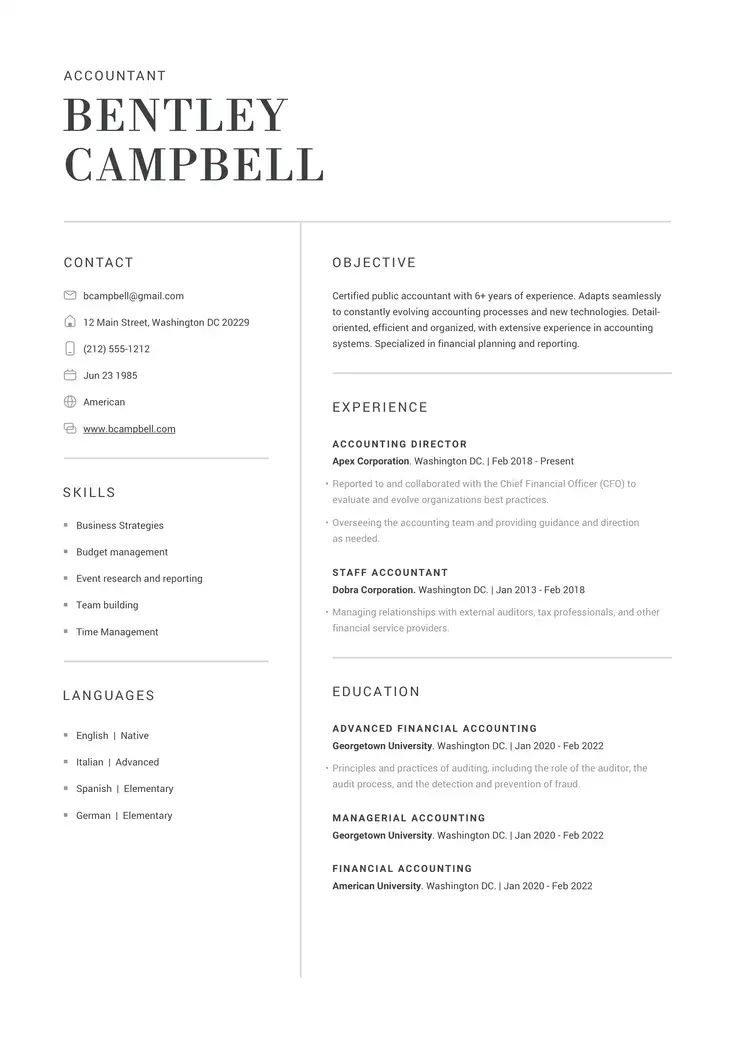Deciding to move to Europe to work is a huge change. Maybe you’re open to a new adventure or just think life can be more interesting abroad.
To get you started on your dive into the foreign job market, we’ve done a little research and compiled the most common jobs in Europe for Americans.
We’ll also go over how to format your resume as a European CV, how to look for jobs, and what visas you’ll need, and more, whether you want to move to Italy, the UK, or another country in Europe.
With this information and our AI resume builder, you can quickly create a European-style resume with ease.
What Jobs Can Americans Get in Europe?
Whether you plan on working for a U.S. company from European soil or you want to find a position in a local company, some positions offer more possibilities than others.
Here are some common positions that you can find in Europe as a U.S. citizen.
English teacher (ESL)
Europe is a continent of many languages; however, English is always highly valued, and by now spoken by almost half of Europeans.
One of the most common jobs for Americans looking to work in Europe is teaching English at a school or academy. English language skills are only going up in demand, and Europeans of all ages are looking to improve their abilities in the world’s business language.
IT technician
IT services are important for companies the world over, and Europe is no exception. In fact, some of the biggest providers of IT services and software manufacturers in the world have headquarters or even originate in Europe itself.
Most programming languages are based on English commands and originate in the U.S. market. On top of that, European companies can always use qualified IT technicians and developers. This can give Americans abroad an advantage in the jobs available.
Au pair
Many parents across Europe are eager to bring their children up bilingual. This, of course, means there are more au pair positions available than ever for English speakers.
This is an excellent opportunity for young college graduates or current college students. Being an au pair not only gives you a great experience of everyday culture.
Customer service assistant
While European countries speak many different languages, there’s still strong demand for customer service staff who are fluent in English. This, of course, makes customer service roles one of the best European jobs for English speakers.
When applying for customer service roles in European countries, such as working at a hotel front desk, it’s important to emphasize your understanding of U.S. cultural norms.
Healthcare professionals
Medical skills are needed all over the world, and Europe is no exception. With an aging population in many countries across the continent, medical professionals are very much in demand.
Whether you’re a fully qualified doctor or a trained nurse, your resume should emphasize your language skills and any cross-cultural experiences you’ve already had in your career.
How To Get a Job in Europe as an American
Unfortunately, you can’t just show up in a European country and start asking for a job, at least not without the right preparation and paperwork.
- Pick your target country: Choose one country and a role. Try to prioritize areas with a shortage to increase your chances of getting a visa sponsorship.
- Localize your CV: Use an EU-friendly resume format, mirror job-ad keywords, and quantify your results and accomplishments.
- Gather essentials: Prepare your diplomas, certifications, and references, and learn basic professional phrases in the local language.
- Network and shortlist: Get in touch with any alumni/recruiters and other Americans working in Europe on LinkedIn, join industry groups, and build a list of employers.
- Apply and plan logistics: Set weekly application goals, track and follow up, prep for time-zone interviews, and understand visa requirements.
If you have or can get citizenship from a European country, the process will be much easier. Otherwise, it’s important to know exactly what the work permit requirements are in the countries you plan on applying to.
How To Adapt an American Resume to a European CV
One of the first things to consider in your European job search is properly formatting your resume. Our resume–building tool makes the formatting job much easier, especially when your application is going to cross the pond.
Some main differences between an American and European resume (or CV) include:
- Photos: They are common on resumes in most European countries
- Length: Resumes in Europe are usually 2-3 pages
- Tone: Resumes are often friendlier
Adding your photo to a resume is necessary in almost every European country. The only exceptions to this are the UK, Ireland, the Netherlands, and Sweden.
To properly format your resume, you’ll have to keep in mind that hiring managers in Europe value certain parts of a section a bit more than managers in the U.S. and Canada.
The Europass format will be your best friend in this process. It’s a standardized format that makes it easy for employers across the continent to understand your qualifications. The Europass CV includes sections like:
- Personal information
- Job-related skills
- Language skills
- Digital skills
- Education and training
- Work experience
- Additional information (e.g., certifications, publications, etc)
Try our AI skills generator to quickly add language skills and more in an impactful way.
What is the Best Way to Look for Jobs in Europe?
Like in the United States, many Europeans use LinkedIn to look for positions in their local area. However, there are a few providers out there who are tailored to American expats. The best sites for finding a job in Europe include:
- Monster Worldwide
- Go Abroad
- Eurojobs
- CareerJet
- Going Global
The European Union also provides EURES, which promotes job listings for every country within the EU.
Alternatively, you could be lucky enough to work for an international company and request a transfer to one of its European offices.
If you’d rather move to Europe independently and aren’t sure what you’ll need to do to get jobs, keep reading.
How To Get a Work Visa in Europe as an American
The key thing that Americans arriving in Europe will need before they land is a valid work permit.
There are a number of different visas you can apply for. The most common visas Americans need to work in Europe, include:
- National work permit: This is the most typical type of permit, which is given when an employer sponsors you.
- EU blue card: Like the green card in the United States, the EU blue card is for highly skilled workers who meet specific salary requirements.
- Digital nomad visa: If you are a remote worker with a stable salary, you can apply for this in certain countries, such as Portugal and Spain.
- Jobseeker visa: This temporary permit allows you to enter a country and seek employment for a specific period. Germany is a country that issues this type of visa.
Be aware, however, that there are different rules for those arriving in the UK, Ireland, and other non-Schengen countries.
FAQs
There are a number of countries Americans choose to go to, typically depending on their sector.
Americans who move to Europe regularly head to Ireland, Germany, the Netherlands, Spain, Portugal, and France.
For example, cities like Dublin and Amsterdam attract tech and finance talent while Barcelona, Madrid, and Lisbon pull remote workers and creatives.
Whether a country is easy to move to will depend on your profile. Portugal is often mentioned as a country with friendly residency paths, including the digital nomad visa, English proficiency, and relatively low costs.
Germany also offers easier routes, as it has a visa that allows qualified professionals to look for a position.
If you are able to get citizenship from an EU country or speak a language other than English, you would also have an advantage in those places.
Demand is particularly strong in healthcare, information technology jobs like cybersecurity, engineering, skilled trades, and logistics.
Many countries in Europe also look for language teachers and hospitality professionals.
These jobs can vary by country and city, and can demand fluency in the native language.
Generally, it’s not easy to get a work visa without a job offer that meets salary requirements or authorization to work remotely as a digital nomad.
Some countries also run labor-market tests to make sure no local or EU candidate is available.
Processing can take weeks to months, and a Schengen tourist status does not allow work. If you plan ahead and target employment shortages, you can improve your chances.
Related Posts





